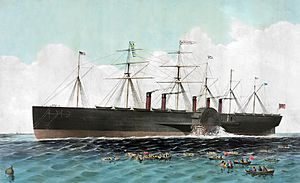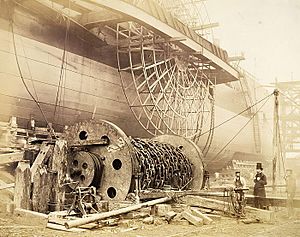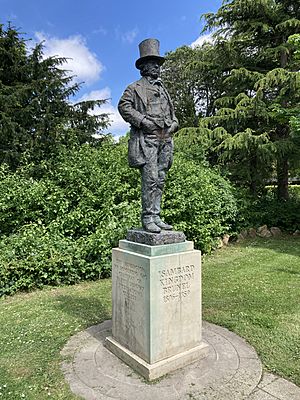Isambard Kingdom Brunel Standing Before the Launching Chains of the Great Eastern facts for kids
This famous photograph, titled Isambard Kingdom Brunel Standing Before the Launching Chains of the Great Eastern, was taken by Robert Howlett in November 1857. It shows Brunel, a brilliant British engineer, during a difficult time. He was trying to launch the SS Great Eastern, which was the biggest ship ever built at that time. Brunel stands in front of a huge drum of chain used to help launch the ship. He looks relaxed, holding his usual cigar case, and his clothes are a bit muddy from the work.
Brunel is smoking a cigar, and his vest is a little crooked. People have described his pose as calm and confident. This picture has become a symbol of the industrial era and the 1800s. It has been printed in many photo collections. The photo was shared widely when the ship finally launched in January 1858. It became popular again after Brunel passed away in 1859.
Contents
Brunel and the Great Eastern Ship
Isambard Kingdom Brunel was a very important British engineer. He designed many amazing projects, like railways and bridges. In 1845, he built the SS Great Britain, which was then the largest ship ever made.
In 1853, Brunel started building the SS Great Eastern. This ship was six times bigger than any other vessel built before it! It was meant to show how powerful Britain was in shipbuilding. This project was one of Brunel's last and most difficult challenges. The ship was about 692 feet (211 m) long and weighed around 22,500 long tons (22,900 t). Because of its massive size, launching it was very hard. It took three months, starting in November 1857, to slide it sideways down a wooden ramp.
The Great Eastern was first planned to carry passengers to the Far East. However, there weren't enough passengers on those routes. So, it was used for trips across the Atlantic Ocean instead. It didn't make much money and was not a success as a passenger ship. But the Great Eastern turned out to be perfect for laying underwater cables. It was used for this job until it was taken apart in 1890. No other ship was bigger than it until the RMS Celtic was built in 1901.
How the Photograph Was Taken
The Illustrated Times newspaper wanted pictures of the new ship for an article about its launch. They hired Robert Howlett to go to the shipyard and take photos. These photos would then be used to create wood-engravings for the newspaper. Howlett was a photographer in London and had been taking pictures since 1852. He had even taken portraits of soldiers from the Crimean War for Queen Victoria and Prince Albert.
Howlett went to the shipbuilding site in Millwall, London, in November 1857. About 10,000 people came to watch the first launch attempt. Howlett took many photos of the ship. He also took six photos of Brunel: three by himself and three with other men. Howlett was one of the first photographers to take pictures of people at their workplace. He carefully chose his shots to show how huge the ship was.
The photos were taken with a box camera using a special method called wet plate collodion. This technique allowed for more detail and faster exposure times. But it meant the photo plate had to be developed right away. So, Howlett likely rushed them to a darkroom on site, perhaps a special tent he designed.
In one of the group photos, Brunel stands near a large drum of chains. These chains were used to hold the ship back as it moved down the ramp. This photo is sometimes called The Great Eastern (wheel and chain drum). A copy of it is kept at the Victoria and Albert Museum. All three individual photos of Brunel show him standing in front of a chain drum.
The most famous of these individual photos is the one titled Isambard Kingdom Brunel Standing Before the Launching Chains of the Great Eastern. In this picture, Brunel stands in a relaxed way, smoking a cigar. He looks away from the camera, with his hands in his pockets. His pants and boots are muddy, and his vest is a bit messy. Brunel wears his cigar case slung over his shoulder, which was his usual style when out in public. Howlett moved his camera to be directly in front of the drum for this shot, after taking other photos from different angles.
In another individual photo, Brunel is in a similar pose and clothes, but he is leaning against the chains. The camera is placed to one side of the drum. In the third individual photo, which is a stereogram (a 3D-like image), Brunel wears lighter pants and doesn't have his pocket watch or cigar. He is sitting on a post in front of the chain drum and looks straight at the camera. His right hand is tucked into his vest.
Sharing the Photograph
The photograph Isambard Kingdom Brunel Standing Before the Launching Chains of the Great Eastern was first captured on a glass photographic plate. A print was likely made from this plate at Howlett's studio. Then, an artist named Horace Harral turned it into an engraving. This engraving was printed in a special edition of the Illustrated Times on January 16, 1858. This was before the ship successfully launched on January 31.
Afterward, the photograph was widely sold as a small card called a carte-de-visite and as a stereoscopic image (for 3D viewers). People at the time said it was "among the most attractive features in the printsellers' shop windows."
These photographs were very important for creating good publicity for the Great Eastern project. The project had faced many delays and money problems. This series of photos became Howlett's most famous work. Sadly, it was also one of his last jobs, as he died from a fever in 1858. After Brunel's death on September 15, 1859, versions of the photograph were published with a copy of his signature on them.
Why the Photo is Important
This photograph, and others like it, are great examples of environmental portraiture. This means taking a portrait of someone in their natural surroundings, like a workplace. This was very hard to do outdoors back then, as most portraits were taken in studios.
The National Heritage Memorial Fund (NHMF) says this image has come to represent the entire industrial era. It has been called "one of the most famous photographs of the nineteenth century and, possibly, of all time."
The photograph has appeared in many books. These include The English Face (1992) by David Piper, Victorian Portraits in the National Portrait Gallery Collection (1996) by Peter Funnell, Chain Reactions (2000) by Adam Hart-Davis, and The Gallery of Fashion (2000) by Aileen Ribeiro. It was also chosen for the Folio Society's 2006 book 100 Greatest Photographs. The National Portrait Gallery also included it in their books 100 Portraits and 100 Photographs.
The Victoria and Albert Museum has a copy of the photograph in its collection. The Brunel Museum bought an original print of the photo in 2019. They received grants from several groups, including the NHMF and the Art Fund. This copy was one of the first prints made directly from the glass plate, likely in Howlett's studio. People voted this print as their favorite Art Fund purchase of 2019.
Some versions of the photograph have caused debate because Brunel's cigar was removed. This is called "tobacco bowdlerization." For example, a version on the cover of a 2006 book called The Life of Isambard Kingdom Brunel, aimed at 5–7 year olds, had the cigar edited out. The publisher thought the cigar was "not iconic" and might hurt sales to schools. The Brunel 200 organization, which planned events for his 200th birthday, criticized this change. A representative from the Institution of Civil Engineers called it "dishonest" censorship. A 2006 statue of Brunel at Brunel University in London, inspired by the photo, also did not include the cigar. The sculptor, Anthony Stones, said it was an artistic choice, not censorship.
See also
- List of photographs considered the most important









